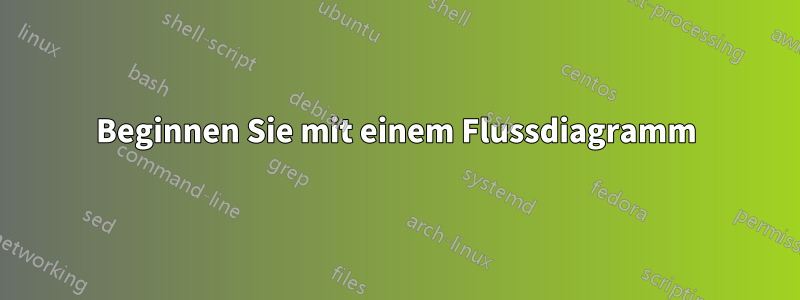
Kann mir jemand beim folgenden Flussdiagramm helfen?
MWE:
\documentclass[tikz, border=6mm]{standalone}
\usetikzlibrary{arrows.meta, positioning, shadows}
\begin{document}
\begin{tikzpicture}[
node distance = 5mm and 7mm,
arr/.style = {-Triangle,very thick},
box/.style = {rectangle, draw, semithick,
minimum height=9mm, minimum width=17mm,
fill=white, drop shadow},
]
\node (n1) [box] {Task};
\node (n2) [box, below right=of n1] {Representation};
\node (n3) [box, above right=of n2] {Skils};
\node (n4) [box, below left=of n2] {Difficulty};
\node (n5) [box, right=of n2] {Solution};
%
\draw[arr] (n1) -| ([xshift=-3mm] n2.north);
\draw[arr] (n3) -| ([xshift= 3mm] n2.north);
\draw[arr] (n4) -| (n2);
\draw[arr] (n2) -- (n5);
\end{tikzpicture}
\end{document}
Antwort1
Damit Ihr Flussdiagramm auf die Seite passt, haben Sie zwei Möglichkeiten:
- Skalieren Sie, indem Sie Optionen hinzufügen
scale=<percent>, transform shape.tikzpictureDies hilft nur einigen; irgendwann müssen Sie ... - Ordnen Sie die Knoten Ihres Flussdiagramms neu an, damit sie passen.
Hier ist der Code:
\documentclass{amsart}
\usepackage{tikz, lipsum}
\usetikzlibrary{positioning, decorations.pathreplacing, calc, arrows.meta, shapes.geometric}
\tikzset{
bigbox/.style={draw, rounded corners, minimum width=2.5cm, minimum height=1.5cm},
smallbox/.style={draw, rounded corners, minimum width=2cm, minimum height=1cm},
bigcircle/.style={draw, circle, minimum size=2cm},
bigellipse/.style={draw, ellipse, minimum width=3cm, minimum height=2.5cm},
place/.style={inner sep=0pt, outer sep=0pt},
fork/.style={decorate, decoration={show path construction, lineto code={
\draw[rounded corners, ->](\tikzinputsegmentfirst)-|($(\tikzinputsegmentfirst)!.5!(\tikzinputsegmentlast)$)|-(\tikzinputsegmentlast);}
}}
}
\begin{document}
\lipsum[1]
\[
\begin{tikzpicture}[scale=.8, transform shape, node distance=1cm, >=Latex]
\node(A)[bigbox]{Text A};
\node(B)[bigbox, right=of A]{Text B};
\node[place](X)[right=3cm of B]{};
\node(C)[smallbox, above=2.5mm of X]{Text C};
\node(D)[smallbox, above=5mm of C]{Text D};
\node(E)[smallbox, below=2.5mm of X]{Text E};
\node(F)[smallbox, below=5mm of E]{Text F};
\node(G)[bigbox, above=of D]{Text G};
\node(H)[bigbox, right=of C]{Text H};
\node(I)[bigbox, below=of H]{Text I};
\node(J)[bigbox, below=of I]{Text J};
\node(K)[bigcircle, below=of J]{Text K};
\node(L)[bigbox, left=of K]{Text L};
\node[place](Y)[left=3cm of L]{};
\node(M)[bigbox, above=2.5mm of Y]{Text M};
\node(N)[bigbox, below=2.5mm of Y]{Text N};
\node(O)[bigellipse, left=3cm of Y]{Text O};
\draw[->](A)--(B);
\draw[fork](B.east)--(D.west);
\draw[fork](B.east)--(C.west);
\draw[fork](B.east)--(E.west);
\draw[fork](B.east)--(F.west);
\draw[->](D)--(G);
\draw[->](C)--(H);
\draw[->](H)--(I);
\draw[->](I)--(J);
\draw[->](J)--(K);
\draw[->](K)--(L);
\draw[fork](L.west)--(M.east);
\draw[fork](L.west)--(N.east);
\draw[fork](M.west)--(O.east);
\draw[fork](N.west)--(O.east);
\end{tikzpicture}
\]
\lipsum[2]
\end{document}
Antwort2
Der „Trick“ besteht darin, z. B. die Klasse „article“ statt „standalone“ zu verwenden. So passt Ihre Zeichnung in eine solche „Standardseite“, wobei sich außer der Einrückung Ihres Codes nichts anderes ändert:
%\documentclass[tikz, border=6mm]{standalone}
\documentclass[10pt]{article}
\usepackage{tikz}
\usetikzlibrary{arrows.meta, positioning, shadows}
\begin{document}
Alice was beginning to get very tired of sitting by her sister on the bank, and of having nothing to do: once or twice she had peeped into the book her sister was reading, but it had no pictures or conversations in it, “and what is the use of a book,” thought Alice “without pictures or conversations?”
\begin{tikzpicture}[
node distance = 5mm and 7mm,
arr/.style = {-Triangle,very thick},
box/.style = {rectangle, draw, semithick,
minimum height=9mm, minimum width=17mm,
fill=white, drop shadow},
]
\node (n1) [box] {Task};
\node (n2) [box, below right=of n1] {Representation};
\node (n3) [box, above right=of n2] {Skils};
\node (n4) [box, below left=of n2] {Difficulty};
\node (n5) [box, right=of n2] {Solution};
%
\draw[arr] (n1) -| ([xshift=-3mm] n2.north);
\draw[arr] (n3) -| ([xshift= 3mm] n2.north);
\draw[arr] (n4) -| (n2);
\draw[arr] (n2) -- (n5);
\end{tikzpicture}
So she was considering in her own mind (as well as she could, for the hot day made her feel very sleepy and stupid), whether the pleasure of making a daisy-chain would be worth the trouble of getting up and picking the daisies, when suddenly a White Rabbit with pink eyes ran close by her.
\end{document}
Antwort3
Durch einfaches Bewegen der Linien
\tikzset{continue chain=going …}
Sie können die Knotenkette an verschiedenen Punkten drehen lassen.
Code
\documentclass[tikz]{standalone}
\usetikzlibrary{arrows.meta, positioning, chains, ext.paths.ortho, quotes, shapes.geometric}
\ExplSyntaxOn\makeatletter\tl_replace_once:Nnn\tikz@do@matrix@cont{\tikz@node@finish}{\tikz@alias\tikz@node@finish}\makeatother\ExplSyntaxOff
\tikzset{tight matrix/.style={every outer matrix/.append style={inner sep=+0pt, outer sep=+0pt}}}
\begin{document}
\begin{tikzpicture}[
node distance = 5mm and 7mm,
arr/.style = {-{Triangle[scale=.75]}, very thick},
arr*/.style= {arr, rounded corners},
box/.style = {rectangle, draw, semithick, rounded corners=3pt,
minimum height=9mm, minimum width=17mm},
boxie/.style={box, minimum height=7mm, minimum width=14mm},
ell/.style = {box, shape=ellipse},
start chain=ch going right,
every join/.append style=arr,
marker/.style={node font=\small, fill=white, inner sep=1pt, outer sep=8pt}
]
\node[box, on chain] (n1) {Task};
\node[box, on chain, join] (n2) {Representation};
\matrix[node distance=1.5cm, on chain=ch, tight matrix]{
\tikzset{start chain=m going below, node distance=3mm}
\foreach \i in {1, ..., 4} \node[boxie, on chain]{};
\\};
\foreach[count=\i]\t in {4, 3, 2, 1}
\path (n2) edge[arr*, horizontal vertical horizontal,
ortho/distance={\i==2||\i==3?4mm:3mm},
"$\t\,\%$" {left, marker, at end}] (m-\i);
\scoped[start chain=x going above]
\chainin (m-begin) node[box, on chain, join] (top) {Hat};
\chainin (m-2);
\node[box, on chain, join] {Pi};
\tikzset{continue chain=going below} % ← turn down!
\node[box, on chain, join] {Pa};
\node[box, on chain, join] {Po};
\node[ell, on chain, join] {Ellie};
\tikzset{continue chain=going left} % ← turn left!
\node[box, on chain, join] (ta) {Turn};
\matrix[node distance=1.5cm, on chain=ch, tight matrix]{
\tikzset{start chain=m going below, node distance=3mm}
\foreach \i in {1, 2} \node[box, on chain]{};
\\};
\node[node distance=1.5cm, ell, on chain] {};
\foreach[count=\i]\t/\u in {A/C, B/D}
\path[arr*, horizontal vertical horizontal]
(ta) edge["$\t$" {right, marker, at end }] (m-\i)
(m-\i) edge["$\u$" {left, marker, at start}] (ch-end);
\end{tikzpicture}
\end{document}






